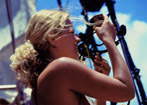|
February 2002
| Jan 16 |
Depart Karang Kapota |
| Jan 17 |
Arrive Kendari, Sulawesi |
03° 58.52' S |
122° 34.47' E |
An intense work stop on board the ship, revamping Synesthesia where we eat and meet. They were long crew days of cementing, painting, woodworking, plumbing. We reconnected with friends that the ship had made in Kendari in 1998. This time they tought us some Sulawesi recipes ñ tumi tumi (squid) curry and steamed banana-coconut cakes wrapped in banana leaf.
| Feb 4 |
Depart Kendari |
| Feb 10 |
Arrive Sawai village, Seram |
02° 57.18' S |
129° 11.00' E |
Roy, the first of many curious locals who hopped on board the ship during our stay in Kendari, was also the last to say goodbye when we left. He had spent most of the last two weeks as Claudiaís woodworking assistant, laying the new floor in Synesthesia. As we departed Kendari, he led the way back to sea.
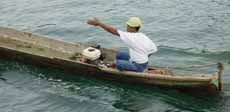

Our voyage across the Banda Sea heading east towards Seram was littered with unexplainable events. The 12-4 watch reported on flashing, flittering, flickering stars ñ bright white lights that flashed to red and green, crossing the sky at low level, speeding up, slowing down, dancing about, then disappearing. The first night was fascinating and made entertaining telling at dinner the next day. But when the spectacles continued in the darkness of the following mid-night watch, our alien alarm bells were ringing. The final light source of the night made sudden moves towards us until me and Mark were hiding behind the rigging boxes and the mizzen mast and Meg was cowering on the helm. We were slightly hysterical as we handed the watch over to the 4-8 who of course saw nothing unusual in the sky.
One night a flying fish leapt right up onto the stern deck, an impressive feat. The next night the sea began to glow, not just against the shipís hull as we disturbed the luminescent creatures beneath us, but up to ten feet from the hull we could make out strange shapes and glittering lights.
"This is a sea of mystery ñ there are creatures within that we donít yet know, something about the water tells me so. We have spectacular light shows at night. As Michel hands over the watch to me at midnight, he paints the sea with his flashlight. The life within it glows and sparkles, creating pools of blue-white within the giant pool of the sea itself. Strings of glittering beads shimmer on the surface as they drift past the bow. Quick movements of the flashlight give the most vibrant shows, regular phosphorescence fades in comparison as it glides past the shipís sides and leaves a trail behind us. The Q beam strikes the surface and it becomes alive with ribbons and rainbow circles.
"This is a sea of depth - weíve been constantly over 3000 metres since leaving the northeast tip of Wowoni behind us.
"This is a sea of emptiness - there are no fishing boats here. We havenít seen a ship since we left Sulawesi. This is a sea that will hold on to the secrets it holds for a while longer."
We arrive at Seram, greeted first by a large leatherback turtle heading out of the bay as we approach. He raises his heavy looking head to take a good look at us, continues to stare as our paths cross and then resumes his passage to sea.
Behind him are pods of dolphins, a huge gathering of spinners. First they lead a couple of fishermen in canoes towards a good dayís catch, then they lead us slowly towards the entrance to Sawai, our anchorage for the next couple of days. But we slow our passage, lower the small boat and approach the dolphins more closely. Some come to ride the bow waves of the Rhadial continuously, while the rest of them stay reasonably close. One by one, we hang off the side of the boat and watch in glee as the dolphins cavort around us, in front, behind, underneath, each side, mothers and their calves, old belligerent looking bulls. Each of us in turn is enchanted by this moment, conscious of our fortune, of the oceanís wealth greeting us so.

We anchor just off Sawai village. The dolphins return that night during dinner to circle the ship. The next day our land exploration begins ñ jungle expeditions to a bird-watching platform 30 metres high. An inspired lady called Djuna who was unfortunately in the States during our visit has set up a bird watching and preservation project here in Seram, masterminding the construction and kitting-out for this platform and converting bird poachers of the forests here into guides. The platform is an hourís walk from the village of Sawai, a walk that begins in the pre-dawn darkness through the village cemetery and into the jungle immediately behind. The birdsí calls increased in intensity as the sun rose and the ground cover thickened. We arrived at the base of the tree that held the platform. Each of us was dressed in safety harnesses, clipped on to a haulyard and raised, like our mainsail by four men rotating a hand-winch carved from wood and not unlike our own capstan.
 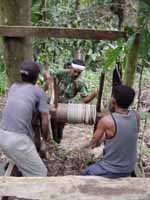 
The platform sits just above the tree canopy, giving a unique view of the rainforest and the life within it. Butterflies mingled around us all morning, hornbills, eagles, lorries, parrots, cockatoos, pigeons flitted in and out of the surrounding branches, some settling just above our heads for a couple of minutes. Nearby was a spectacular series of caves cluttered with birdsí nests and bats at the entrance, strange spiders and many more bats inside.
The waters around this north side of Seram are not as spectacular as the forest. We dove beyond the two pearl farms, one Chinese and one Japanese-owned. The corals were a little smothered by sedmient and algae and the fish were sparse. A derelict resort of three cottages on stilts and a beautiful octagonal cabana like at the mouth of the bay, a sign that things in Seram have been deeply affected by the war in Ambon. Tourists have been through here before, but not recently. We were the first visitors in the last two years.
During this voyage, we are retracing the voyages of Alfred Wallace, evolutionary theorist and slightly unfortunate traveller according to his reports in ëThe Malay Archipelagoí. His experience in Seram was definitely not as uplifting as ours. Not only did he find Seram lacking in numbers of birds, but he also found himself on the south coast of the island, waiting to leave for Waigeo (our next destination also) and having to anchor in a bay for the night to seek protection from a sudden storm. While he slept fitfully in the rocking boat, the captain and his crew abandoned him, taking all small boats and most provisions with them and leaving the hapless Wallace with his research assistants stranded. He fired his musket to summon the attention of the village chief who took mercy on him and sent out a rescue boat. Wallace delayed his voyage to Waigeo.
But we didn't.
| Feb 14 |
Depart Seram |
| Feb 17 |
Arrive Waigeo |
00° 20.50' S |
130° 59.96' E |
A couple of days in the Seram Sea which again glows green at night. One night we illuminate the ocean and catch sight of extraordinary flying fish ñ bright white bodies, angel like wings. The bright lights dazzle them and one dashes himself against the hull in confusion.
We dive the shoal at the entrance to Dampier Straits ñ we enter a sea teeming with fish, walls of surgeon fish, unicorn fish, fusiliers so thick it almost feels like they will block our passage. There are jacks hunting, a large jobfish scouring the reef for food. The current increases in strength and the second divers are approached by a manta ray that soars around them for a while.
That night, we are drifting gently towards Waigeo and a whale comes close to the ship at two in the morning. Dolphins arrive a little later and make phosphorescent trails around the ship for about 10 minutes.
On our morning of arrival at Waigeo, three lights flash brightly in the sky as the sun rises. We change our anchorage plans, put off by the pearl farm in the bay, and cruise the south coast until we find our own empty bay. Birds welcome us, a deafening cacophony from the surrounding jungle.
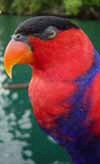 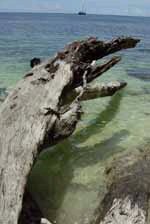 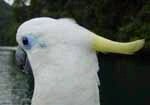
We spend the next two days exploring the coastal waters of Waigeo, and the channel that opens into a massive bay in the middle of the island. The bird life here was even more impressive than in Seram ñ we saw many hornbills, several eagles, kites, sulphur-crested cockatoos, black cockatoos, kingfishers. The logging companies have only just arrived here, a small patch of forest cleared already but so far they will have made no assault on the bird population. The birdlife over the sea south of Waigeo is vibrant ñ boobies chasing terns who are chasing tuna. We watched this display before diving the reef here which was very unexceptional. One of the dive teams caught a fish, the first fish we have caught for ourselves in a very long time. But the fish took its revenge and somehow in the struggle to bring the reluctant mackerel onto the small boat, the inflatable was punctured, limping back to the ship with one compartment looking like a flat tyre. Dive plans for the following day were abandoned and emergency repairs carried out to undo the fishís damage.
Canoes came by the ship daily to show us their catches ñ cockatoos and parrots tethered to the outriggers, a cuscus (small mammal) lies flat on its back in another boat and we watch three fishermen haul their catch from the net next to our anchor chain ñ an elasmobranch textbook: adult black tip reef shark, a baby black tip, a blue spotted ray and a leopard shark struggling to continue breathing.
 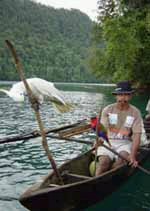 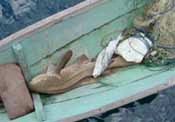
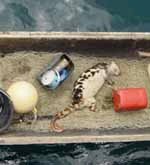
One of the higlights of our time at Waigeo was an encounter with two pairs of Indopacific humpback dolphins ñ they surfaced just beside us and stayed fairly close to our small boat while we cruised our bay. One broke away from his partner to come closer to our bow and show us the pink markings on the end of his snout and the latter spine of his dorsal fin, very pretty animals. Their lethargic movements and lazy tail-flicking were a beautiful sight on a drizzling afternoon, exploring this island.
| Feb 21 |
Depart Waigeo |
| Feb 25 |
Arrive Biak |
01° 11.81' S |
136° 05.60' E |
More than 300 dolphins surround us as we head south to find the channel before heading northwest towards Irian Jayaís coast and the equator. Once we round Cape Horn (a less dramatic version than that on the African continent) a massive current sends us directly straight south east towards Biak.
We hove to on 24th Feb and allow the Heraclitus and Michel to cruise and dawdle on their birthdays, and Carol anticipates hers the next day.
We arrive at Biak in the midst of a cetacean explosion ñ three types of dolphin (spinners and common among them) and a pod of small whales which might have been false killer whales. The fishing canoes have just left the island and headed westwards, the animals are heading the same way but we go east and drop anchor just off the town of Biak.
|


